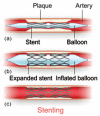Coating Techniques and Release Kinetics of Drug-Eluting Stents
- PMID: 31156736
- PMCID: PMC6542673
- DOI: 10.1115/1.4031718
Coating Techniques and Release Kinetics of Drug-Eluting Stents
Abstract
Implantation of drug-eluting stents (DESs) via percutaneous coronary intervention is the most popular treatment option to restore blood flow to occluded vasculature. The many devices currently used in clinic and under examination in research laboratories are manufactured using a variety of coating techniques to create the incorporated drug release platforms. These coating techniques offer various benefits including ease of use, expense of equipment, and design variability. This review paper discusses recent novel DES designs utilizing individual or a combination of these coating techniques and their resulting drug release profiles.
Keywords: Coronary stents; Drug release kinetics; Drug-eluting stents; Interventional cardiology; Stent coatings.
Figures





Similar articles
-
Coronary Artery Stents(Archived).2023 Jun 5. In: StatPearls [Internet]. Treasure Island (FL): StatPearls Publishing; 2025 Jan–. 2023 Jun 5. In: StatPearls [Internet]. Treasure Island (FL): StatPearls Publishing; 2025 Jan–. PMID: 32644713 Free Books & Documents.
-
Drug-eluting stents.Arch Cardiol Mex. 2006 Jul-Sep;76(3):297-319. Arch Cardiol Mex. 2006. PMID: 17091802 Review.
-
Recent progress in percutaneous coronary intervention: evolution of the drug-eluting stents, focus on the XIENCE V drug-eluting stent.Coron Artery Dis. 2010 Jan;21(1):46-56. doi: 10.1097/MCA.0b013e328333f550. Coron Artery Dis. 2010. PMID: 19952925 Review.
-
Development of Novel Drug-Eluting Stents for Acute Myocardial Infarction.Chonnam Med J. 2017 Sep;53(3):187-195. doi: 10.4068/cmj.2017.53.3.187. Epub 2017 Sep 25. Chonnam Med J. 2017. PMID: 29026706 Free PMC article. Review.
-
[Recent developments of drug eluting stent coatings].Yao Xue Xue Bao. 2011 Nov;46(11):1301-7. Yao Xue Xue Bao. 2011. PMID: 22260019 Review. Chinese.
Cited by
-
Influence of Drug Incorporation on the Physico-Chemical Properties of Poly(l-Lactide) Implant Coating Matrices-A Systematic Study.Polymers (Basel). 2021 Jan 18;13(2):292. doi: 10.3390/polym13020292. Polymers (Basel). 2021. PMID: 33477626 Free PMC article.
-
Coil and flow diverting stents as drug delivery platforms for cerebral aneurysm treatment.bioRxiv [Preprint]. 2025 Jun 27:2025.06.24.661344. doi: 10.1101/2025.06.24.661344. bioRxiv. 2025. PMID: 40666945 Free PMC article. Preprint.
-
Cardiovascular Stents: A Review of Past, Current, and Emerging Devices.Materials (Basel). 2021 May 12;14(10):2498. doi: 10.3390/ma14102498. Materials (Basel). 2021. PMID: 34065986 Free PMC article. Review.
-
Laser Microperforation Assisted Drug-Elution from Biodegradable Films.Pharmaceutics. 2022 Oct 9;14(10):2144. doi: 10.3390/pharmaceutics14102144. Pharmaceutics. 2022. PMID: 36297579 Free PMC article.
-
Rise of implantable drugs: A chronicle of breakthroughs in drug delivery systems.Saudi Pharm J. 2024 Dec;32(12):102193. doi: 10.1016/j.jsps.2024.102193. Epub 2024 Oct 30. Saudi Pharm J. 2024. PMID: 39564378 Free PMC article. Review.
References
-
- NHS. Atherosclerosis. National Health Service; Redditch, UK: 2014. http://www.nhs.uk/conditions/atherosclerosis/Pages/Introduction.aspx.
-
- Rao SV, Califf RM, Kramer JM, Peterson ED, Gross TP, Pepine CJ, Williams DO, Donohoe D, Waksman R, Mehran R, Krucoff MW. Postmarket Evaluation of Breakthrough Technologies. Am Heart J. 2008;156(2):201–208. - PubMed
-
- Newsome LT, Kutcher MA, Royster RL. Coronary Artery Stents: Part I. Evolution of Percutaneous Coronary Intervention. Anesth Analg. 2008;107(2):552–569. - PubMed
-
- Kuntz RE, Piana R, Pomerantz RM, Carrozza J, Fishman R, Mansour M, Safian RD, Baim DS. Changing Incidence and Management of Abrupt Closure Following Coronary Intervention in the New Device Era. Cathet Cardiovasc Diagn. 1992;27(3):183–190. - PubMed
-
- Serruys PW, Kutryk MJB, Ong ATL. Coronary-Artery Stents. N Engl J Med. 2006;354(5):483–495. - PubMed
Grants and funding
LinkOut - more resources
Full Text Sources
Other Literature Sources
